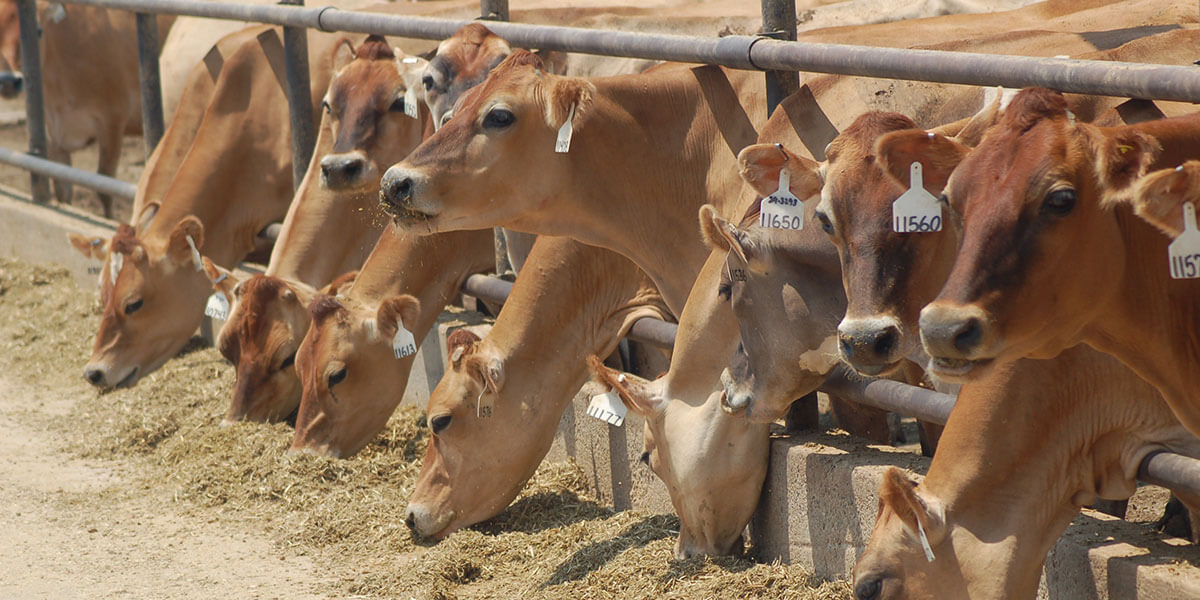Heat stress in animals can result in costly economic losses for producers. Across the beef, dairy, poultry and swine industries, economic losses from reduced production and reproduction performance and increased mortality can reach as high as $2.4 billion annually (St-Pierre, Cobanov, and Schnitkey. 2003).
Heat stress can have a negative effect on many production factors in all species, some apparent right away and some delayed. Heat-stressed animals reduce feed intake as a way to reduce metabolic heat. Lower feed intake results in reduced milk production in dairy cattle and reduced growth rates in beef cattle, swine and poultry.
During heat stress, animals may divert energy and nutrients away from production purposes and use them instead for heat dissipation or for inflammatory responses to immune challenges. After heat stress, animals are not quick to switch their nutrient utilization back to production mode, which may cause a reduction in production performance even one or two months down the road.
Heat Stress Management and Leaky Gut in Animals
Heat stress can cause a condition called leaky gut, which can have immediate effects on your livestock and poultry, but it also plays a role in delayed effects in the fall.
During heat stress, an animal’s core body temperature increases, causing blood flow to be diverted away from the gastrointestinal tract to the skin surface in order to increase heat dissipation. This causes a reduction in the amount of oxygen (hypoxia) and energy available to the enterocytes (single layer of epithelial cells) lining the intestinal tract. This can weaken the tight junctions that hold the enterocytes together, allowing pathogens and their toxins to transfer into the bloodstream, causing leaky gut.
Once the bacteria, pathogens or their toxins pass between cells, the immune system recognizes them and triggers an immune response to destroy and remove the invaders. This inflammatory process and immune system activation consumes significant amounts of nutrients, pulling nutrients and energy away from other key functions within the animal such as growth, reproduction, and meat, milk, or egg production.
Heat Stress Leads to Lameness in Cattle
Reduced feed intake and leaky gut during a period of heat stress can, ultimately lead to lameness in cattle and swine lameness in the fall, even after the temperature has gone down.
The chronic inflammation that occurs due to leaky gut causes a reduction in keratinocyte proliferation that makes up the foot horn tissue. This reduction in keratinocyte number results in the formation of lower-quality foot horn tissue throughout the summer, a little at a time, and will eventually lead to cow hoof problems, like lameness, in the fall.
In addition, during periods of heat stress, dairy and beef cattle spend more time standing in order to dissipate heat beneath them. This increased standing time can result in additional hoof problems, such as sole ulcers.
Many producers use sprinklers and evaporative coolers to help dissipate heat stress, but they can sometimes contribute to lameness. When cattle stand in water from sprinklers and evaporative coolers, this can soften the sole of the hoof and separate the sole from the wall of the hoof.
Heat Stress Contributes to Seasonal Infertility
Heat stress also contributes to seasonal infertility, particularly in late summer and early fall. The two production issues that can impact seasonal infertility the most are heat stress and decreased nutritional intake.
We know that during a heat stress event, feed intake will decline. Animals with a lower body condition score (BCS) from reduced feed intake won’t exhibit as strong signs of estrus, will have a reduction in conception rates, a reduction in the number of embryos produced and an increase in embryonic mortality. In sows, this will lead to a reduction in litter size, fewer weaned pigs and fewer marketed pigs down the line.
Sows with a reduced BCS will need to pull from their body reserves to make an adequate amount of milk for their piglets during lactation, which will lead to a further-reduced BCS.
Trace Mineral Nutrition and Heat Stress Management
Livestock and poultry producers can help mitigate the negative effects of heat stress by feeding a more nutrient-dense diet in the summer to compensate for the reduction in feed intake. Producers can consider replacing some of the fiber in the ration with fat to increase the number of calories the animal is consuming.
Feeding higher levels of performance trace minerals during the summer can also play a positive role in mitigating the negative effects from heat stress.
Research shows that feeding zinc from Zinpro® Availa® Zn plays a role in maintaining intestinal integrity by strengthening tight junctions during challenges and reducing the incidence of leaky gut and related intestinal inflammation.
Chromium from Zinpro® Availa® Cr or Zinpro® MICROPLEX® can increase thermal tolerance as well, as it helps to reduce the level of cortisol or corticosterone — involved in regulation of energy, immune reactions and stress responses — in animals. Elevated levels of cortisol or corticosterone cause animals to behave in a hectic manner, expend energy and, ultimately, reduce feed intake. Lowering cortisol and corticosterone levels by feeding diets containing Availa-Cr or MICROPLEX can help keep animals calm and more willing to eat during heat stress events.
Oxidative stress occurs when free radicals and antioxidants are out of balance. Zinc, copper, manganese and selenium work as antioxidants by removing free radicals and protecting cell membranes from oxidative stress.
Contact a Zinpro representative today to learn more about including Zinpro Performance Minerals® like Zinpro® Availa® Cr, Zinpro® MICROPLEX®, Zinpro® Availa® Zn, Zinpro® Availa® Mn, Zinpro® Availa® Cu, and Zinpro® Availa® Se into your livestock and poultry nutrition programs.
Note: Not all products are available in all markets.

